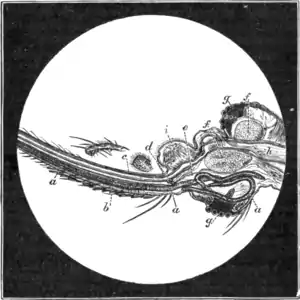< Page:Tropical Diseases.djvu

This page has been proofread, but needs to be validated.
XL]
TRANSMISSION
697
infected, and after many meals of banana, they could still be found coiled up in the head or stretched out in the labium. Probably heat and moisture play a part in this respect, as has been shown to be the case by Fülleborn.

Fig. 107.—F. bancrofti in head and proboscis of mosquito.
a, a, a, Filariæ; b, labium; c, labrum; d, base of hypopharynx; e, duct of veneno-salivary gland; f, f, cephalic ganglia; g, g, eye; h, œsophagus; i, pharyngeal muscle.
These observations prove that, like the malaria parasite, the filaria is introduced into its human
- ↑ solution, and placed them on the stage of the microscope. He separated the various parts of the proboscis by a slight pressure so as to observe more clearly, and placed the flame of a Bunsen burner close to the slide. He noticed that the filariæ moved violently within the labium when the liquid in which the mosquito was bathed attained a higher temperature. Finally, one managed to pierce its way through at the tip of the labium, and was soon followed by others. He noticed the escape of five filariæ within a minute. Sometimes two passed simultaneously. Too high a temperature killed both larvæ and mosquito. A fall of temperature arrested the process.
This article is issued from Wikisource. The text is licensed under Creative Commons - Attribution - Sharealike. Additional terms may apply for the media files.